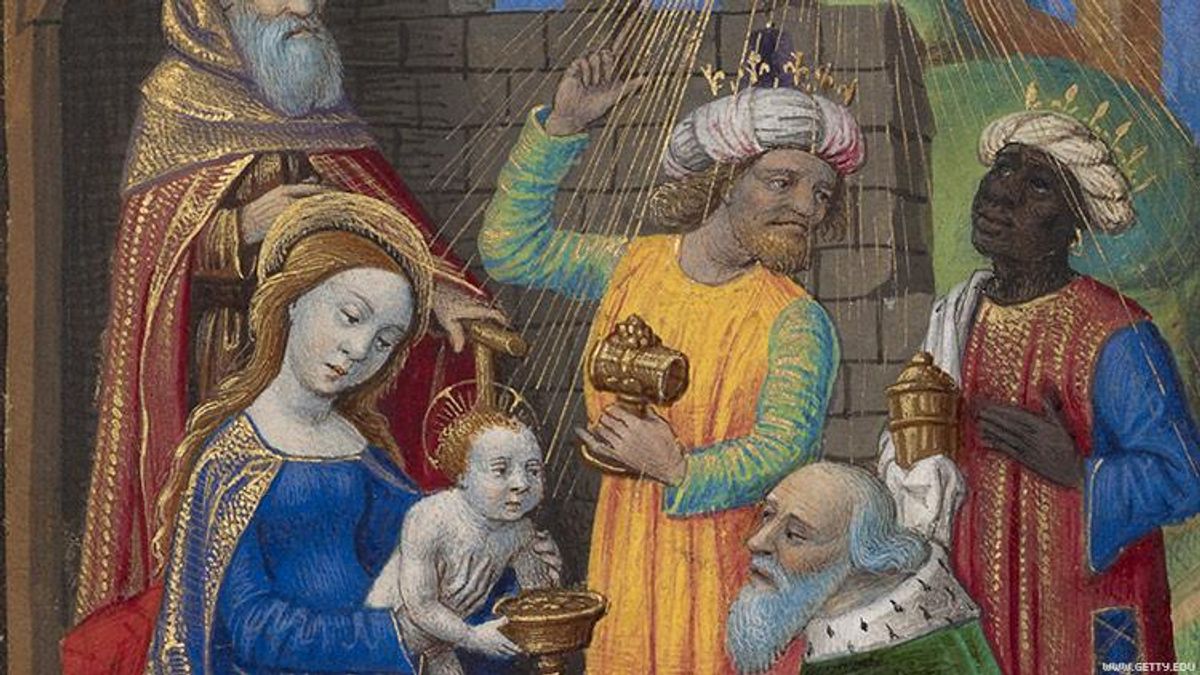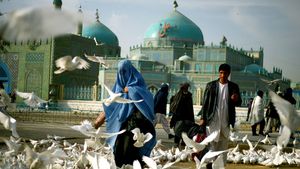Medieval manuscripts preserve stories of romance, faith, and knowledge, but their luxurious illuminations can reveal hidden prejudices as well. On view at the Getty Center in Los Angeles is the exhibition "Outcasts: Prejudice and Persecution in the Medieval World," which examines the "out-groups" living within Western Europe through case studies of manuscripts drawn from the museum's collection, on view through April 8.
Contemporary interpretations of the thousand years of history encompassed by the term "the Middle Ages" have tended to reflect a homogenous, Eurocentric, Christian view of the world. This exhibition points out that medieval society was far more diverse than is commonly understood, but diversity did not necessarily engender tolerance. Life in the Middle Ages presented significant obstacles for those who were not fully abled, white, wealthy, Christian, heterosexual, cisgender males.
The Getty Museum houses a world-class collection of splendidly illuminated and gilded manuscripts. Typically created for the privileged classes, such books nevertheless have the power to provide glimpses of the marginalized and powerless, reflecting their tenuous places in society. Attitudes toward Jews and Muslims, the poor, those perceived as sexual or gender deviants, and the peoples beyond European borders can be discerned through caricature and polemical imagery as well as through marks of erasure and censorship.
Several of the case studies in the exhibition treat the topic of the enslavement of peoples living within the boundaries of Western Europe. The Islamic world stretched as far west as the Iberian Peninsula (Spain and Portugal). When King James I of Aragon (1208-1276) ordered Bishop Vidal de Canellas (about 1190-1252) to compile a manuscript of the feudal customs of Aragon, Christians and Muslims had battled for control of the region for nearly 700 years. Such laws regulated many of the daily activities of Jews and Muslims living in Christian-ruled territories. One section of the harsh text legislates the movements of enslaved "Moors" (a medieval catchall term for Muslims and black Africans) living in Christian lands. The law forbids Jews and Christians to return these slaves to their homeland.
In a book of hours made for Rene of Anjou (1400-1480), the illuminator Georges Trubert followed a late-medieval tradition of symbolically depicting each of the Magi -- stargazers who brought gifts to the Christ Child -- as a ruler from one of the continents known to Europeans: the kneeling figure as Europe and the standing kings as Asia and Africa (identified by their turbans, used stereotypically in art to identify Muslims, Jews, or peoples of the eastern and southern Mediterranean and beyond). The black African Magus is a paradoxical figure. His presence reveals the racial diversity in Europe at a time when ecumenical church councils welcomed delegates from Ethiopia to Florence and Rome. At the same time, however, Europeans began to engage in the brutal African slave trade.
Other examples in the exhibition treat forms of control and persecution that were not officially legislated by church or state but were no less destructive in their scope. A composite manuscript from East Anglia, England -- begun around 1190 as a picture cycle of Christ's life with devotional supplements from about 1480-1490 -- provides the only remaining medieval image of Robert of Bury, an obscure child saint said to have been murdered by Jews. Blood libel is the incendiary claim that Jews killed Christian children for use in rituals that often mocked the Crucifixion. The scenes at the upper left show a woman (possibly an accomplice) hiding Robert's body in a well and, at right, an archer discovering the corpse. The establishment of Robert's cult appears to have been politically motivated. When two candidates vied for the seat of abbot of Bury St. Edmunds, the ultimate victor, Samson, campaigned on the claim that his opponent allowed the town's Jewish moneylenders access to the abbey church. Under Abbot Samson, Robert's vita was written and a shrine erected for his veneration.
Events from the past could be leveraged as powerful propaganda in the present. Following the Ottoman sultan's 1453 capture of the city of Constantinople, the capital of eastern Christendom, the Burgundian dukes Philip the Good (1396-1467) and his son Charles the Bold (1433-1477) commissioned manuscripts with crusading narratives. One text narrates the feats of Charles Martel, an eighth-century French leader who prevented the advancement of Moorish armies from the Iberian Peninsula into Francia (France). Both dukes were committed to defending Christian lands against the Ottoman Turks. In contrast to the Christian charity often presented in expensively decorated devotional manuscripts, Duke Charles was known for wearing lavish garments made from cloth-of-gold silk, imported from Tabriz in Persia (Iran). He incurred large debts, and his dealings with foreign cloth merchants as well as the Medici Bank, among others, led to bankruptcy.
Some medieval writers and artists altered historical content in their works to align it with the prevailing morals of the day. Giovanni Boccaccio's lurid 14th-century stories with moralizing twists featured individuals who had fallen from lofty positions of power. The early medieval Merovingian queen Brunhilde, a historical figure who led armies and ruled over kingdoms, fell victim to the misogyny of later medieval authors who cast her as the archetypal "nasty woman." An early-15th-century illuminator from Paris depicted Brunhilde dragged by a horse, after which she would be drawn and quartered. Variations of this story described her as ruthless and vengeful, characterizations also applied at the time to Saracens (a pejorative term for Muslims). This parallel may explain the turbaned hybrid figures in the margins, which often served as a space for commentary on the larger picture. The "Saracen" in medieval art became a catchall category of people to be feared.
The Classical world-ruler Alexander the Great's lovers included the young man Hephaistion and the eunuch Bagoas, but in one medieval account Bagoas was recast as a beautiful woman, called Bagoe, in order to "avoid a bad example," according to the text. In the illumination, Bagoe wears luxurious garments like those of the spear-carrying Amazon women in the background, who were renowned for their military prowess and heightened sexual drive. The literary and artistic regendering of Bagoas/Bagoe reveals the predominant prejudice against same-sex attraction and, by analogy with the Amazons, the pervasive wariness toward powerful women.
Embellishing his account of political negotiations at the French court, historian Jean Froissart (1337-1405) shared a defamatory anecdote: He wrote that Jean, Duke of Berry (1340-1416), was infatuated with a boy at court who specialized in manufacturing knitted undergarments. The artist depicted the duke, at far right, placing his hand on the shoulder of the youth, whose short tunic and hose reveal his buttocks, as was fashionable at the time. Froissart's "outing" of this French ruler exemplifies a frequent tactic for undermining a person's moral and spiritual reputation.
For today's viewer, the vivid images and pervasive subtexts in these beautifully illuminated manuscripts can serve as stark reminders of the power of rhetoric and the danger of prejudice.We invite you to join the conversation on the Getty Iris or on social media at #MedievalOutcasts.
KRISTEN COLLINS and BRYAN C. KEENE are curators of "Outcasts: Prejudice and Persecution in the Medieval World," on display at Los Angeles's Getty Center until April 8.


















































































Here's our dream all-queer cast for 'The White Lotus' season 4